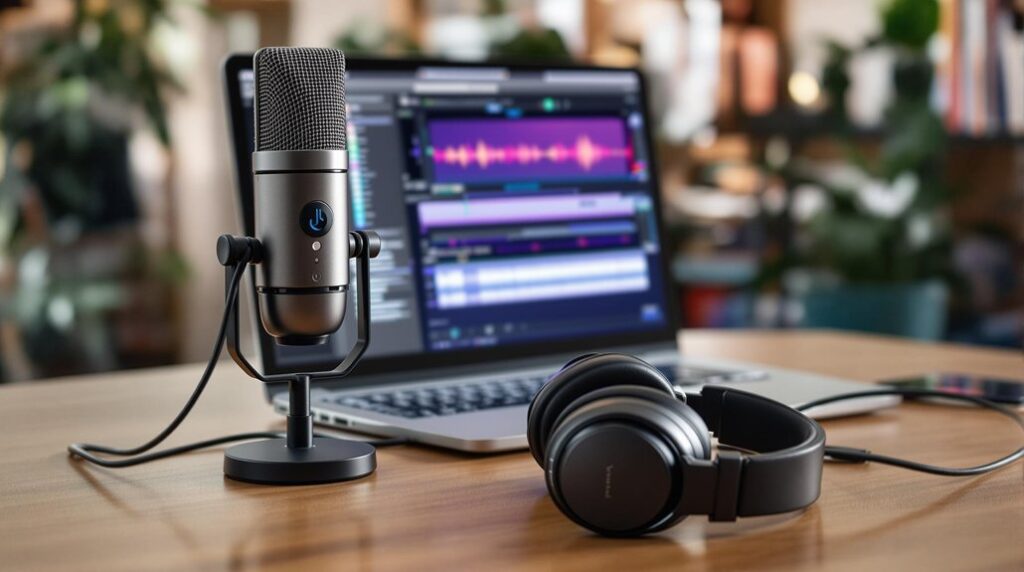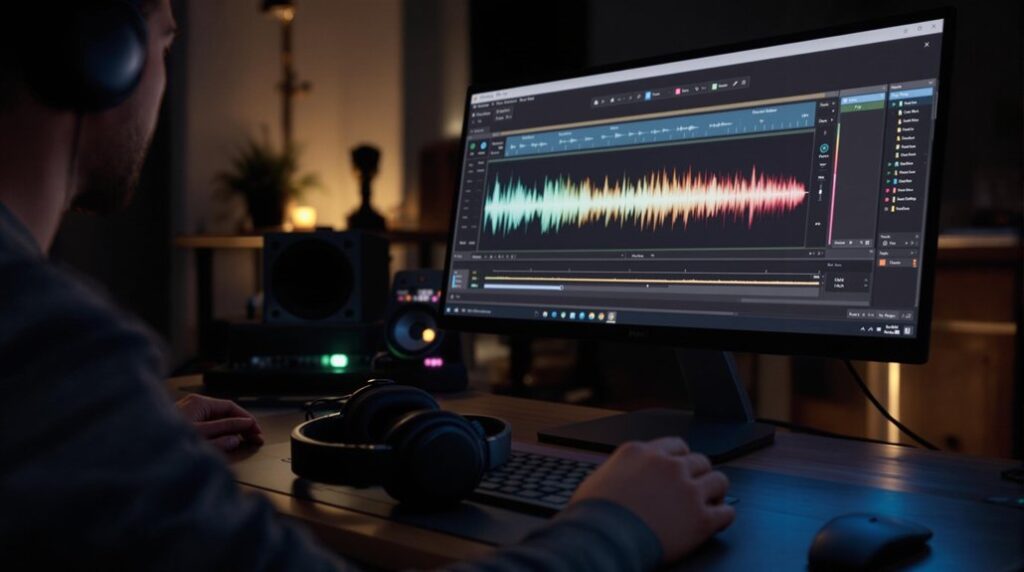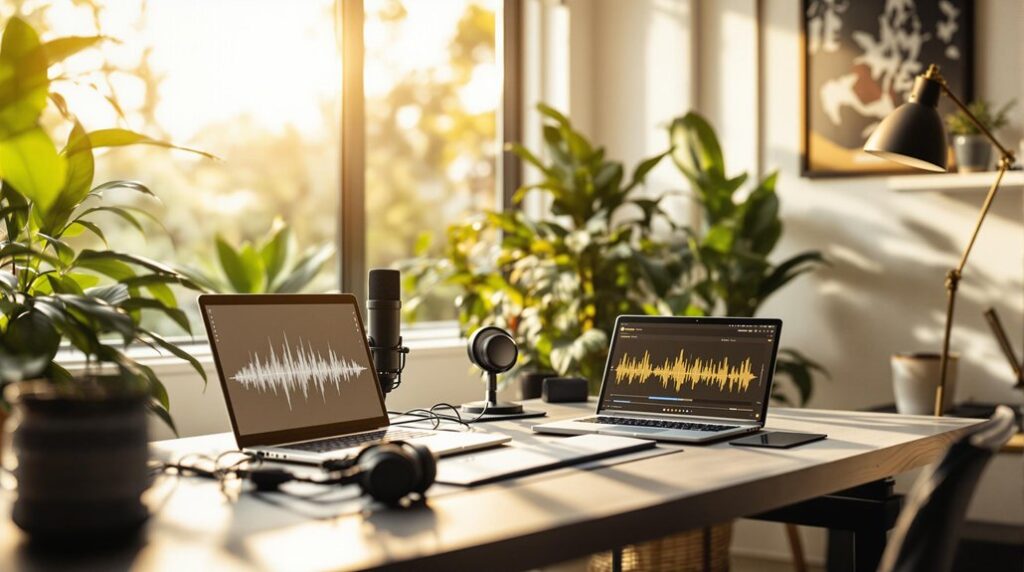To vocode audio in Audacity, follow these three simple steps. First, set up your project by importing one voice track as the modulator and a synthesized sound track as the carrier. Use “Make Stereo” in the tracks menu for effective mixing. Second, select the voice track, navigate to the “Effect” menu, and choose the vocoder option. Start with default settings and adjust the amplitude and vocoder bands as desired for enhanced sound manipulation. Finally, use the preview function to listen to your adjustments in real-time. Continue to explore more techniques to refine your unique audio design.
Key Takeaways
- Download and install Audacity, preparing one voice track as the modulator and a synthesized sound as the carrier.
- Create stereo tracks by selecting “Make Stereo” in the tracks menu for effective audio mixing.
- Access the “Effect” menu and select the vocoder option, starting with default settings for initial sound processing.
- Adjust the amplitude of white noise from 0% upward to enhance the vocoder effect as desired.
- Use the preview function to listen in real-time and fine-tune vocoder bands for optimal sound control.
Understanding Vocoding
Vocoding, a transformative audio process, intricately combines a modulator, often a voice, with a carrier signal, typically a synthesized sound. This technique produces hybrid sounds that range from robotic voices to harmonically rich textures, making it indispensable across various music genres.
The vocoder effect simulates a classical analog multiband vocoder, allowing for detailed sound manipulation through an adjustable number of Vocoder bands, with a default setting of 40 bands. By manipulating parameters such as distance and amplitude, users can control the responsiveness of the modulator within the output, enhancing the desired effect.
Additionally, applying Vocoder to stereo channels can create expansive soundscapes, including the use of white noise for further texture. Understanding reverb’s origins can also enhance the overall depth and character of vocoded sounds in music production.
Setting Up Audacity
Before starting on your vocoding project, it is essential to set up Audacity correctly. Begin by downloading Audacity from the official website to guarantee compatibility with your Windows or Mac system. Install the software by following the prompts, which will prepare your environment for audio editing.
Familiarize yourself with the layout of menus and basic audio functions to enhance your workflow. Confirm that your audio tracks are ready; you will need a voice track as the modulator and a synthesized sound track as the carrier signals.
To create something unique, make stereo tracks by selecting “Make Stereo” in the tracks menu. This setup will allow you to effectively mix stereo and access the Audacity Vocoder, paving the way for your vocoding process. Additionally, ensure that you have correct audio device settings configured in Audacity to enable smooth audio capture.
Applying the Vocoder Effect
To apply the vocoder effect in Audacity, first select your voice track, which serves as the modulator, and navigate to the “Effect” menu. Make sure to choose the vocoder option from the list. Begin with the default settings, which provide a foundational starting point for your audio effect. Adjust the amplitude of the white noise or another sound, starting at 0% and increasing as necessary to enhance the vocoding effect. Experiment with the number of vocoder bands, as more bands offer finer control over frequency manipulation. Use the preview function to listen to real-time adjustments before finalizing the vocoder effect, ensuring the desired outcome for both beginners and seasoned users. Understanding the importance of music production trends can also help you stay ahead in the evolving landscape of audio effects.
| Setting | Description |
|---|---|
| Modulator Track | Your selected voice track |
| Carrier Sound | White noise or another sound |
| Amplitude | Starting at 0%, adjust as needed |
| Vocoder Bands | More bands for finer control |
| Preview Function | Listen to adjustments in real-time |
Frequently Asked Questions
How to Vocode Audio in Audacity?
To vocode audio in Audacity, adjust vocode settings within the plugin installation, applying audio effects for sound modulation. Utilize creative mixing techniques and audio layering for vocal enhancement, enhancing your music production with unique textures.
How to Use Vocode?
To effectively use vocode effects in audio manipulation, engage in sound design by layering synthesizers, adjusting pitch, and enhancing vocal harmonics. This technique is essential for audio engineering and creative mixing, yielding unique auditory experiences.
How Do I Make Audio in Audacity?
To create audio in Audacity, utilize various audio editing techniques, apply sound effects, enhance vocals through voice modulation, and employ software plugins for ideal audio mastering. Always minimize background noise for superior recording quality.
How to Make Your Voice Recordings Sound Professional Using Audacity?
To achieve professional voice recordings in Audacity, focus on microphone selection, recording environment setup, and background noise reduction. Incorporate voice modulation tips, audio editing techniques, vocal warm-up exercises, and mastering audio tracks to enhance overall sound quality.
Conclusion
To summarize, vocoding audio in Audacity involves a clear understanding of the vocoder effect, proper setup of the software, and the application of the effect to achieve desired results. By following the outlined steps, users can effectively manipulate audio to create unique soundscapes. Mastery of this technique enhances audio production capabilities, allowing for innovative and creative expressions within various audio projects. Such proficiency in using Audacity contributes greatly to the field of sound design and music production.




